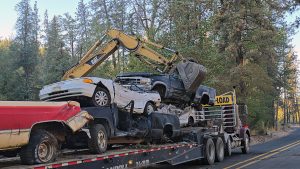By the CUJ
MISSION – The Confederated Tribes plan a new round of purchasing a dozen fractionalized interests on a dozen parcels, some of which have more than a dozen owners.
The process can be long and cumbersome, especially if the parcels are in the probate process for owners who have died.
The 12 parcels are 40-80 acres in size, but there are multiple owners for each piece of land.
“That’s over 100 owners on up to 800 acres,” said Bill Tovey, director of the CTUIR Department of Economic and Community Development.
It’s all part of a CTUIR effort to consolidate land on the reservation, Tovey said.
A study completed in 1990 prior to the negotiations with NW Pipeline showed that more than half of reservation is owned by non-Tribal members.
The Umatilla Indian Reservation contains 1,300 allotments with as many as 300 owners. The Tribes own about 90 percent of the land in about 50 allotments, and own 100 percent of another 400 allotments.
Much of the fractionalized interests are owned by enrolled members of other tribes. The federal Bureau of Indian Affairs (BIA) rules provide CTUIR the opportunity to purchase those interests when there is 50 percent ownership by the Tribes. Through the Umatilla Inheritance Code there is an Option to Purchase when the landowner dies with no Umatilla heirs, but the probate process can take years.
For example, Tovey said, “If a Yakama landowner here dies with no Umatilla heirs the Tribes (CTUIR) have the opportunity to purchase that interest.”
The BOT in two different resolutions passed Nov. 16 approved the staff to pursue the purchases.
One resolution addresses only one parcel – the 40-acre Allotment UM 209, which is located west of the Nixyaawii Charter School and adjacent to the Bowman property where the CTUIR is planning to develop housing.
Tovey said the Tribes own 90.5 percent of that allotment, but 14 others (Yakama and Nez Perce Indians) own the remaining 9.5 percent (about four acres) with six probates on that parcel. Because ownership is undivided interest, less than 10 percent or four acres is owned by all 15 owners, including the CTUIR, who retain part of the overall property.
One of the remaining owners may possess just a quarter acre, but it’s part of the overall 40 acres that can’t be divided.
Acquiring the full ownership of the allotment would ensure the parcel is available for any needed tribal housing or community development, according to the BOT resolution.
The goal, Tovey said, is to purchase as much fractionalized land as possible, but not so much that the government owns it all.
“There has to be land for businesses and for tribal members to build houses. The Tribe should not own all Trust property. The American Dream for tribal members is land and homeownership,” he said.
The probate process is as complicated as it unwieldly and time consuming.
“It’s still in probate and not completely owned by the Tribes, but we work with the BIA,” Tovey said. remaining optimistic that the parcels can become CTUIR-owned sooner than later.
The BIA represents deceased Indian owners of land in probate, the process of which can often take from three to 10 years.
“In the non-Indian world if it takes longer than a year, something is the matter,” he said.
For the pieces that aren’t in probate, the CTUIR needs consent from the living allotee before it can negotiate the purchase.
CTUIR resolutions, which outline the Tribes’ intent to purchase from living owners, are sent to the superintendent of the BIA (Michael Jackson). Once an appraisal has been completed, which determines Fair Market Value, the BIOA sends a letter notifying land owners that the CTUIR intends to purchase their land.
“A lot don’t respond. Some may not even know where the land is,” Tovey said. “Once we agree on an appraisal for the sale the owner gets a letter saying the Tribe is purchasing the property, Hopefully then a payment would be made to the landowner.”
Some of the parcels, particularly on a grazing allotment, are so small that checks for 2-cents have been mailed to owners.
“A little piece of grazing land, with a $20 animal unit per acre, will be pennies,” Tovey said.
In most cases, that administrative work costs more than the value of the fractionalized parcel. Tovey said a study by the Indian Land Tenure Foundation found that about $300 is spent on a single allotment each year.



